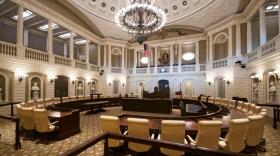A rare atmospheric event may send another a surge of Arctic air our way. A sudden stratospheric warming is weakening the polar vortex, and is setting the stage for what could be one of the coldest Decembers in years.
Boston Globe meteorologist Ken Mahan explains what a Sudden Stratospheric Warming event is and why this is so unusual for November.
Ken Mahan, Boston Globe: Well, I'll tell you, it's sort of looking at it simply like the atmosphere is a seven layer cake. There're multiple levels from the troposphere at the surface where we see the weather every single day. But then there is the stratosphere above that, and there are weather elements that can basically impact - like gears of a watch - what happens in the stratosphere will impact what we see [happen in] the troposphere.
So, sudden stratospheric warming is, simply put, warming temperatures in the higher upper level atmosphere, which will push against the polar vortex, which is a band of winds around the North Pole, slowing them down where it will unlock and release pockets of cold air.
We haven't seen this happen this early during November since the 1960s, so it's something that we haven't seen in a long time.
Carrie Healy, NEPM: So when is this sort of weakened or displaced polar vortex more usual for us to experience in New England?
We usually see it more so in the depths of winter, and probably most commonly as we transition out of winter into spring.
You think of winter, of course, being a cold season, spring warming things up. You have very contrasting air masses with more cold than warm air. So, this usually happens later on in the winter season.
This early is pretty unusual, especially since we haven't seen a few of the more normal climatological patterns like La Niña or a couple of the oscillations, which is just a fancy word of saying 'wind pattern cycles' favoring colder winter across New England and really North America.
So, it's it's been the first time in a while since we've had this setup.
So, based on the models that you watch, what's the timeline for when this colder than normal stretch will hit us here in Western Mass? And how long will it stick around?
So the latest forecasting for this sort of 'cold wave' we'll call it, is just shortly after the Thanksgiving holiday, beginning on Black Friday, and spilling into the weekend and then really peaking during the first week of December.
I am seeing that the polar vortex breakup will be a little bit, uh, I'll put it this way; A little bit staggered. It won't be a five day stretch where it's just constantly cold. We're going to see a very cold day, followed by a somewhat seasonable day, and then followed by another couple of cold, cold days. So it's going to be broken up a little bit, but peaking, during the week and the weekend after Thanksgiving and then into the first week of December.
Okay, so you mentioned La Niña and other climate patterns also at play. And as we head into early December, This will bring those frigid temperatures. But is there also other potential for significant snow and ice?
It's funny, I do see that we're going to see more snowfall this season, especially over the last couple of winters, particularly away from the coast, thinking the Berkshires, the Green and White Mountains [which are] already starting off with a pretty decent snowfall season for the month of November.
Many happy folks that enjoy the ski slopes and snowboarding slopes are sharing their photos on social media and whatnot, but all kinds of [data is] pointing towards a colder, more snowier track this winter, especially across the interior portions of New England.
If you think about Boston, it's probably going to end up more seasonal in terms of temperatures and less snowfall than average, but more snowfall across the coast than what we've seen in the last couple of years, maybe even combined.





